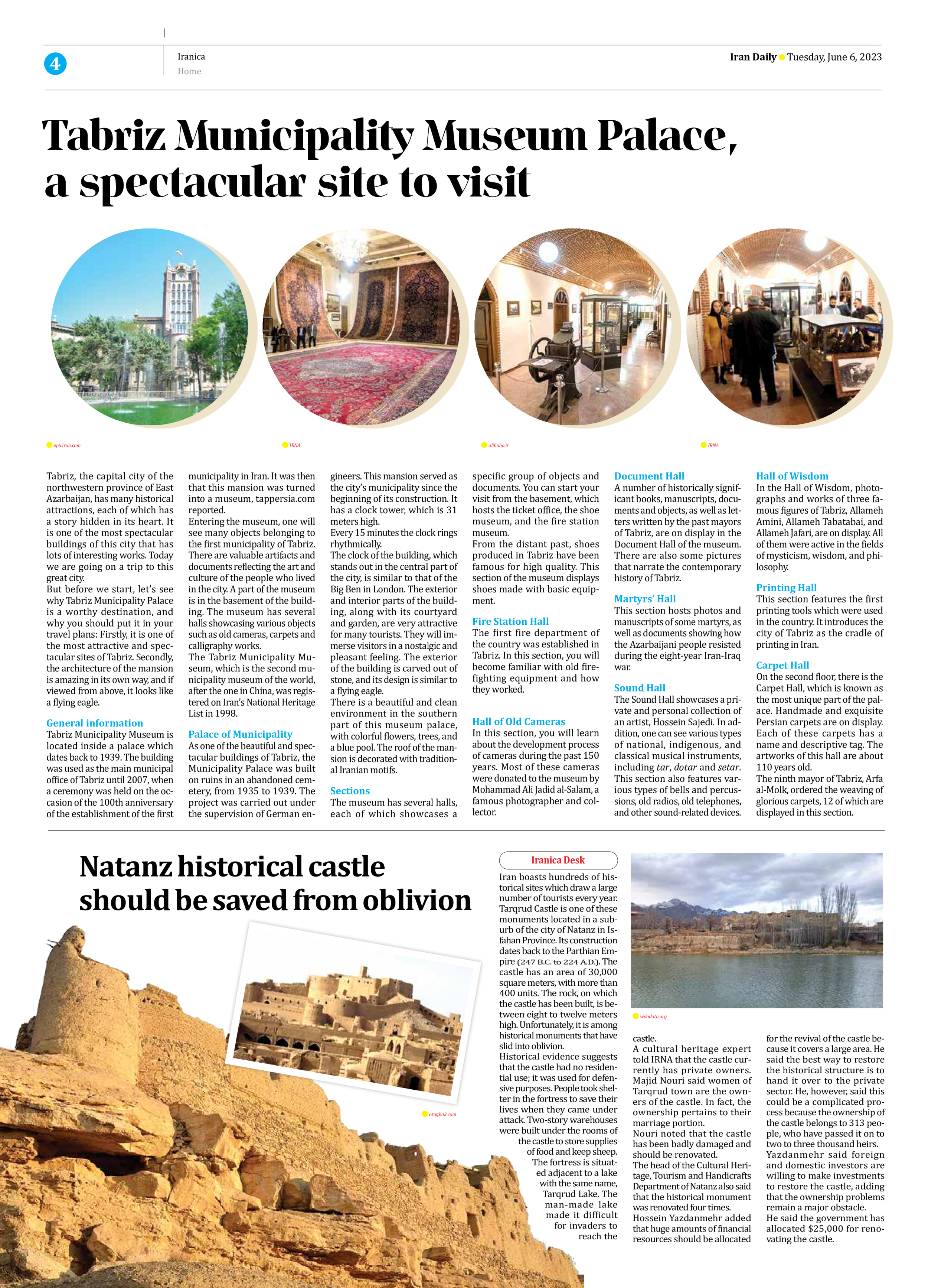
Tabriz Municipality Museum Palace, a spectacular site to visit
Tabriz, the capital city of the northwestern province of East Azarbaijan, has many historical attractions, each of which has a story hidden in its heart. It is one of the most spectacular buildings of this city that has lots of interesting works. Today we are going on a trip to this great city.
But before we start, let’s see why Tabriz Municipality Palace is a worthy destination, and why you should put it in your travel plans: Firstly, it is one of the most attractive and spectacular sites of Tabriz. Secondly, the architecture of the mansion is amazing in its own way, and if viewed from above, it looks like a flying eagle.
General information
Tabriz Municipality Museum is located inside a palace which dates back to 1939. The building was used as the main municipal office of Tabriz until 2007, when a ceremony was held on the occasion of the 100th anniversary of the establishment of the first municipality in Iran. It was then that this mansion was turned into a museum, tappersia.com reported.
Entering the museum, one will see many objects belonging to the first municipality of Tabriz. There are valuable artifacts and documents reflecting the art and culture of the people who lived in the city. A part of the museum is in the basement of the building. The museum has several halls showcasing various objects such as old cameras, carpets and calligraphy works.
The Tabriz Municipality Museum, which is the second municipality museum of the world, after the one in China, was registered on Iran’s National Heritage List in 1998.
Palace of Municipality
As one of the beautiful and spectacular buildings of Tabriz, the Municipality Palace was built on ruins in an abandoned cemetery, from 1935 to 1939. The project was carried out under the supervision of German engineers. This mansion served as the city’s municipality since the beginning of its construction. It has a clock tower, which is 31 meters high.
Every 15 minutes the clock rings rhythmically.
The clock of the building, which stands out in the central part of the city, is similar to that of the Big Ben in London. The exterior and interior parts of the building, along with its courtyard and garden, are very attractive for many tourists. They will immerse visitors in a nostalgic and pleasant feeling. The exterior of the building is carved out of stone, and its design is similar to a flying eagle.
There is a beautiful and clean environment in the southern part of this museum palace, with colorful flowers, trees, and a blue pool. The roof of the mansion is decorated with traditional Iranian motifs.
Sections
The museum has several halls, each of which showcases a specific group of objects and documents. You can start your visit from the basement, which hosts the ticket office, the shoe museum, and the fire station museum.
From the distant past, shoes produced in Tabriz have been famous for high quality. This section of the museum displays shoes made with basic equipment.
Fire Station Hall
The first fire department of the country was established in Tabriz. In this section, you will become familiar with old firefighting equipment and how they worked.
Hall of Old Cameras
In this section, you will learn about the development process of cameras during the past 150 years. Most of these cameras were donated to the museum by Mohammad Ali Jadid al-Salam, a famous photographer and collector.
Document Hall
A number of historically significant books, manuscripts, documents and objects, as well as letters written by the past mayors of Tabriz, are on display in the Document Hall of the museum. There are also some pictures that narrate the contemporary history of Tabriz.
Martyrs’ Hall
This section hosts photos and manuscripts of some martyrs, as well as documents showing how the Azarbaijani people resisted during the eight-year Iran-Iraq war.
Sound Hall
The Sound Hall showcases a private and personal collection of an artist, Hossein Sajedi. In addition, one can see various types of national, indigenous, and classical musical instruments, including tar, dotar and setar. This section also features various types of bells and percussions, old radios, old telephones, and other sound-related devices.
Hall of Wisdom
In the Hall of Wisdom, photographs and works of three famous figures of Tabriz, Allameh Amini, Allameh Tabatabai, and Allameh Jafari, are on display. All of them were active in the fields of mysticism, wisdom, and philosophy.
Printing Hall
This section features the first printing tools which were used in the country. It introduces the city of Tabriz as the cradle of printing in Iran.
Carpet Hall
On the second floor, there is the Carpet Hall, which is known as the most unique part of the palace. Handmade and exquisite Persian carpets are on display. Each of these carpets has a name and descriptive tag. The artworks of this hall are about 110 years old.
The ninth mayor of Tabriz, Arfa al-Molk, ordered the weaving of glorious carpets, 12 of which are displayed in this section.







